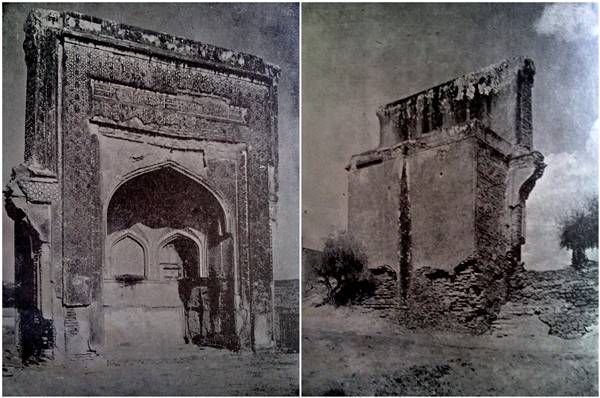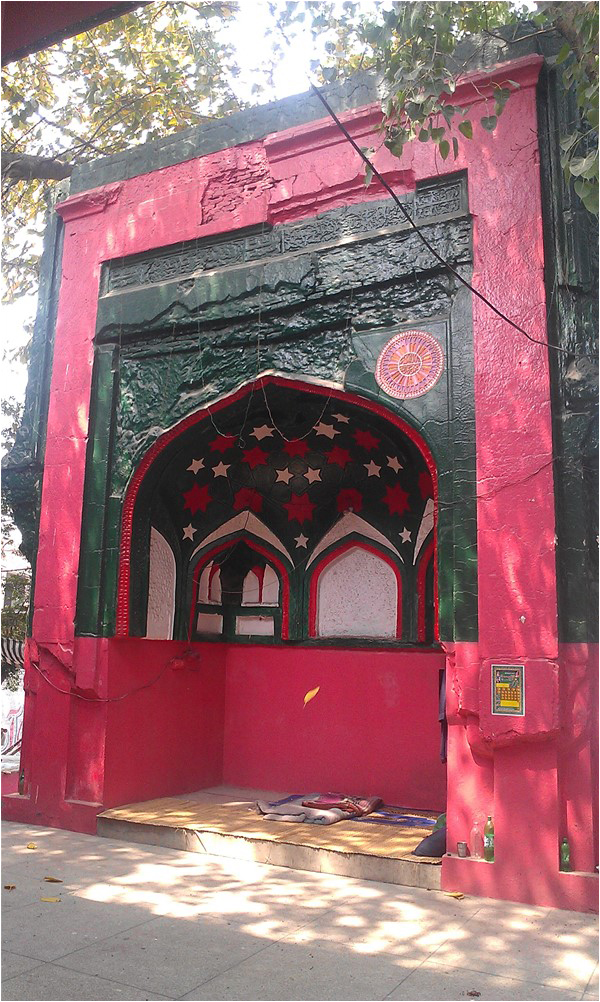
It is widely believed that Delhi was the only capital and permanent settlement of the Sultans of Delhi, despite the fact that the first capital amongst the various other capitals of the Delhi Sultanate was Lahore. Lahore, being a historical city, holds the material and non-material culture of the region – not just from the Mughal era but also from medieval and ancient times. The rule of the Delhi Sultanate, to which historian Abraham Eraly refers to as “the age of wrath”, has an enormous number of controversies associated with it, not only because it led to a prodigious shift in the living patterns and paradigms of the people of the Indian subcontinent, but also because it was an outcome of a series of military conquests which tremendously uprooted the local administrative and social structures, laying forth novel traditions.
Apart from the historical mausoleum of Sultan Qutb-ud-din Aibak in Anarkali, the founder of the Delhi Sultanate, little is generally seen and known to be part of the Sultanate era in Lahore. However, towards the north of Lahore in an area today known as Kot Khwaja Saeed, an ancient monument withstands the dust and broil of the polluted environment. Judge Muhammad Latif, who was a noted historian, mentioned this monument by the name ‘Hujra Mir Mahdi’ in his book regarding the history of Lahore, and believes that this is the oldest extant monument of Lahore. The Hujra is believed to be a part of an Eid-gah or Janaz-gah of those days, built in 1421 or 1422 A.D.
Historically, after the plundering and fierce attacks of Timur in 1398 A.D., people inhabiting Lahore fled to the peripheries of the city in order to save their lives and riches. After Timur’s raids, Lahore was sadly known to be a city where only owls lived. When the Mongol forces moved out of the city after much looting and killing, Raja Jasrat Ghakkar took control of the city. Later on Mubarak Shah, Sultan of the Sayyid dynasty, seizing power and becoming the ruler of Delhi, came with his armies to Lahore and routed Raja Jasrat Ghakkar. Following were the attempts to re-inhabit and rebuild the city by Sultan Mubarak Shah, who invited all the traders and businessmen from the sub-continent to come to Lahore. He also sent his soldiers and representatives in the peripheries of the city to urge the people to come back, who fled during Timur’s raids. At that time Mubarak Shah built this monument as a spot to perform Eid prayers or Janazah (funeral) prayers to facilitate and captivate people around it. Regarding the name of the Hujra, the opinion is that it was named after Mir Majzub Mahdi Shirazi ibn Mas’um Ali Shah Shirazi, publically known as Mullah Sad’ra Shirazi, of whom Sultan Mubarak Shah is known to be a disciple of in his young age and as an affair of respect and devotion he named the Hujra after him. Interestingly, Hazrat Mian Mir (1550-1635 A.D.) used to stay in this Hujra as mentioned by Dara Shikoh (1615-1659 A.D.), brother of Mughal emperor Aurangzeb Alamgir, in his books, ‘Safinah al Awliah’ and ‘Hasnaat al Arafein’.

The days when the Hujra was built, Lahore was a city surrounded by mud walls, and thus it was known as the ‘mud-walled city’. Near the Hujra is the tomb of Sayyid Miran Hussain Zanjani who is known to be the first Sufi saint to enter Punjab and preach to people in 1040 A.D. He was the disciple of Sheikh Abu al Fazal Khatli of whom Sayyid Ali Hajveri (also known as Data Sahib) is also known to be a disciple.
Unfortunately, there are no local records present which can elaborately explain the personality of Mir Majzub Mahdi and his relation with Sultan Mubarak Shah. Majid Sheikh has referred to the Department of Oriental Studies of the British Museum Library where there are some Persian records, which quite extensively explain this subject. Contrary to this, another opinion regarding the Hujra is that this area was occupied by a person named Mir Mahdi during the Mughal era and thus it is named as the Hujra of Mir Mahdi. But this opinion lacks any documented proof and seems to be a weaker narration than that of Mir Majzub Mahdi. However, the construction is definitely as old as mentioned earlier in the article and there are no objections as regards the date it was constructed on.
Unfortunately as far as the preservation status of the Hujra is concerned, it is under no special privilege beyond the other historical monuments of Lahore. Even more unfortunately, the Hujra is not even known in the historical perspective mentioned above. The local caretaker of the Hujra says that he is serving the place since his childhood and so did his father. He sadly expressed that neither the Auqaf nor the Cultural Heritage department ever visited the place. The Hujra is regarded with religious respect by local people, as it has the Kalima inscribed on it.
Apart from the historical mausoleum of Sultan Qutb-ud-din Aibak in Anarkali, the founder of the Delhi Sultanate, little is generally seen and known to be part of the Sultanate era in Lahore. However, towards the north of Lahore in an area today known as Kot Khwaja Saeed, an ancient monument withstands the dust and broil of the polluted environment. Judge Muhammad Latif, who was a noted historian, mentioned this monument by the name ‘Hujra Mir Mahdi’ in his book regarding the history of Lahore, and believes that this is the oldest extant monument of Lahore. The Hujra is believed to be a part of an Eid-gah or Janaz-gah of those days, built in 1421 or 1422 A.D.
The Hujra is believed to be a part of an Eid-gah or Janaz-gah of those days
Historically, after the plundering and fierce attacks of Timur in 1398 A.D., people inhabiting Lahore fled to the peripheries of the city in order to save their lives and riches. After Timur’s raids, Lahore was sadly known to be a city where only owls lived. When the Mongol forces moved out of the city after much looting and killing, Raja Jasrat Ghakkar took control of the city. Later on Mubarak Shah, Sultan of the Sayyid dynasty, seizing power and becoming the ruler of Delhi, came with his armies to Lahore and routed Raja Jasrat Ghakkar. Following were the attempts to re-inhabit and rebuild the city by Sultan Mubarak Shah, who invited all the traders and businessmen from the sub-continent to come to Lahore. He also sent his soldiers and representatives in the peripheries of the city to urge the people to come back, who fled during Timur’s raids. At that time Mubarak Shah built this monument as a spot to perform Eid prayers or Janazah (funeral) prayers to facilitate and captivate people around it. Regarding the name of the Hujra, the opinion is that it was named after Mir Majzub Mahdi Shirazi ibn Mas’um Ali Shah Shirazi, publically known as Mullah Sad’ra Shirazi, of whom Sultan Mubarak Shah is known to be a disciple of in his young age and as an affair of respect and devotion he named the Hujra after him. Interestingly, Hazrat Mian Mir (1550-1635 A.D.) used to stay in this Hujra as mentioned by Dara Shikoh (1615-1659 A.D.), brother of Mughal emperor Aurangzeb Alamgir, in his books, ‘Safinah al Awliah’ and ‘Hasnaat al Arafein’.

The days when the Hujra was built, Lahore was a city surrounded by mud walls, and thus it was known as the ‘mud-walled city’. Near the Hujra is the tomb of Sayyid Miran Hussain Zanjani who is known to be the first Sufi saint to enter Punjab and preach to people in 1040 A.D. He was the disciple of Sheikh Abu al Fazal Khatli of whom Sayyid Ali Hajveri (also known as Data Sahib) is also known to be a disciple.
Unfortunately, there are no local records present which can elaborately explain the personality of Mir Majzub Mahdi and his relation with Sultan Mubarak Shah. Majid Sheikh has referred to the Department of Oriental Studies of the British Museum Library where there are some Persian records, which quite extensively explain this subject. Contrary to this, another opinion regarding the Hujra is that this area was occupied by a person named Mir Mahdi during the Mughal era and thus it is named as the Hujra of Mir Mahdi. But this opinion lacks any documented proof and seems to be a weaker narration than that of Mir Majzub Mahdi. However, the construction is definitely as old as mentioned earlier in the article and there are no objections as regards the date it was constructed on.
Unfortunately as far as the preservation status of the Hujra is concerned, it is under no special privilege beyond the other historical monuments of Lahore. Even more unfortunately, the Hujra is not even known in the historical perspective mentioned above. The local caretaker of the Hujra says that he is serving the place since his childhood and so did his father. He sadly expressed that neither the Auqaf nor the Cultural Heritage department ever visited the place. The Hujra is regarded with religious respect by local people, as it has the Kalima inscribed on it.

